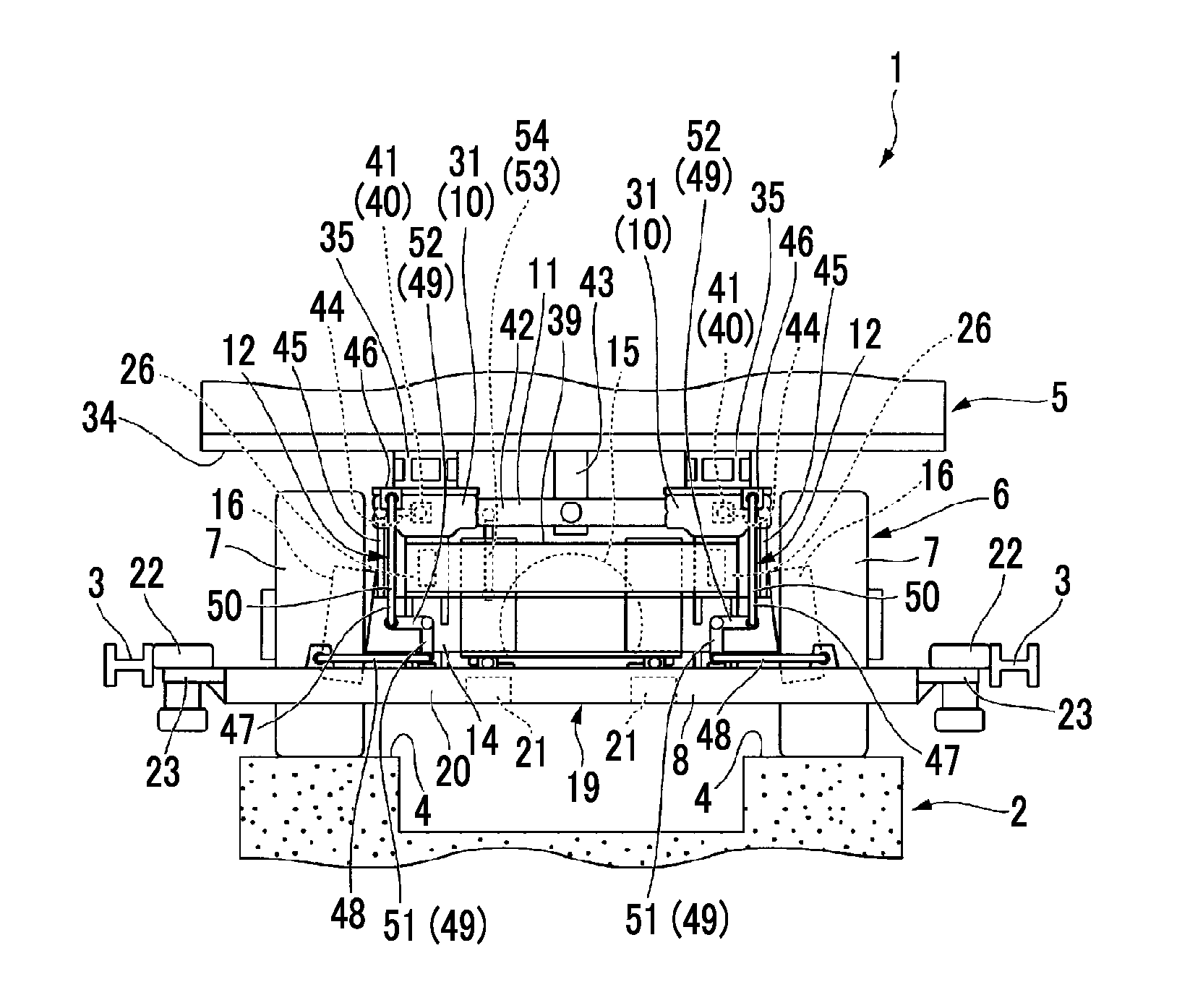Track-guided vehicle, and car body tilt control method therefor
- Summary
- Abstract
- Description
- Claims
- Application Information
AI Technical Summary
Benefits of technology
Problems solved by technology
Method used
Image
Examples
first embodiment
[0055]Hereinafter, a guide-rail track vehicle 1 in the present invention will be described.
[0056]FIGS. 1 to 3 illustrate the guide-rail track vehicle 1 in the first embodiment. The guide-rail track vehicle 1 in the first embodiment travels on a travel path 4 while being guided by guide rails 3 which are so-called side guide rails and are disposed respectively in the opposite lateral side portions of a track 2.
[0057]As illustrated in FIGS. 1 to 3, the guide-rail track vehicle 1 includes a car body 5 and a bogie 6.
[0058]The car body 5 (refer to FIGS. 2 and 3) is formed in a rectangular parallelepiped hollow shape which is long in a longitudinal direction. The inner space of the car body 5 acts as a space for accommodating passengers.
[0059]The bogies 6 can travel on the travel path 4, and support bottoms of front and rear portions of the car body 5, respectively. The bogie 6 includes a pair of travelling wheels 7; a steering device 8; a suspension apparatus 9; a dampening apparatus 10;...
second embodiment
[0127]Accordingly, during a normal operation of the guide-rail track vehicle of the second embodiment, it is possible to automatically control the height of the air spring 31 using the leveling valve 41 and the adjustment rod 45 such that the car body 5 is not brought into a tilted state. In contrast, in order to tilt the car body 5, it is possible to individually adjust the height of each of the air springs 31 using the bypass pipe 65 and the second 3-way electromagnetic switching valve 64.
[0128]Since the height of each of the air springs 31 is adjusted by the bypass pipe 65 and the second 3-way electromagnetic switching valve 64 in a state where the leveling valve 41 is restricted from adjusting the height of the air spring 31, an operation of the leveling valve 41 can be prevented from disturbing the tilting of the car body 5. Accordingly, the respective heights of the air springs 31 are set to be different from each other, and thus the car body 5 is tilted. As a result, it is po...
sixth embodiment
[0179]Accordingly, in the guide-rail track vehicle of the sixth embodiment, it is possible to calculate the normal lateral acceleration, in which the cant of the track 2 is taken into consideration. For this reason, it is possible to calculate an optimal tilt angle required to tilt the car body 5 toward the inner rail when the vehicle rounds a curve.
[0180]Subsequently, a guide-rail track vehicle in a seventh embodiment of the present invention will be described. Since a partial configuration of a guide-rail track vehicle is the only difference between the third embodiment and the seventh embodiment, a description will be given with the same reference signs assigned to the same parts. The guide-rail track vehicle in the seventh embodiment includes the car body 5 and the bogie 6, and the bogie 6 includes a pair of the travelling wheels 7; the steering device 8; the suspension apparatus 9; the dampening apparatus 10; the car body tilting mechanism 11; the detection unit 12; and a tilt ...
PUM
 Login to View More
Login to View More Abstract
Description
Claims
Application Information
 Login to View More
Login to View More - R&D
- Intellectual Property
- Life Sciences
- Materials
- Tech Scout
- Unparalleled Data Quality
- Higher Quality Content
- 60% Fewer Hallucinations
Browse by: Latest US Patents, China's latest patents, Technical Efficacy Thesaurus, Application Domain, Technology Topic, Popular Technical Reports.
© 2025 PatSnap. All rights reserved.Legal|Privacy policy|Modern Slavery Act Transparency Statement|Sitemap|About US| Contact US: help@patsnap.com



